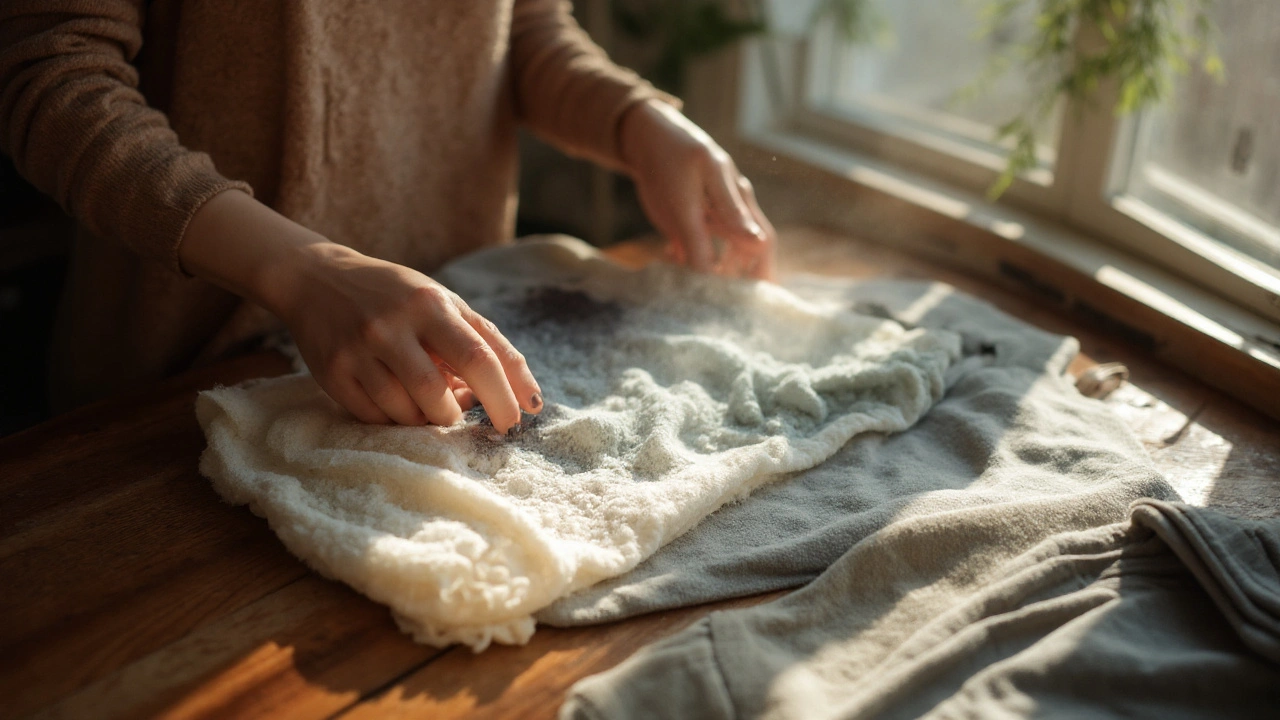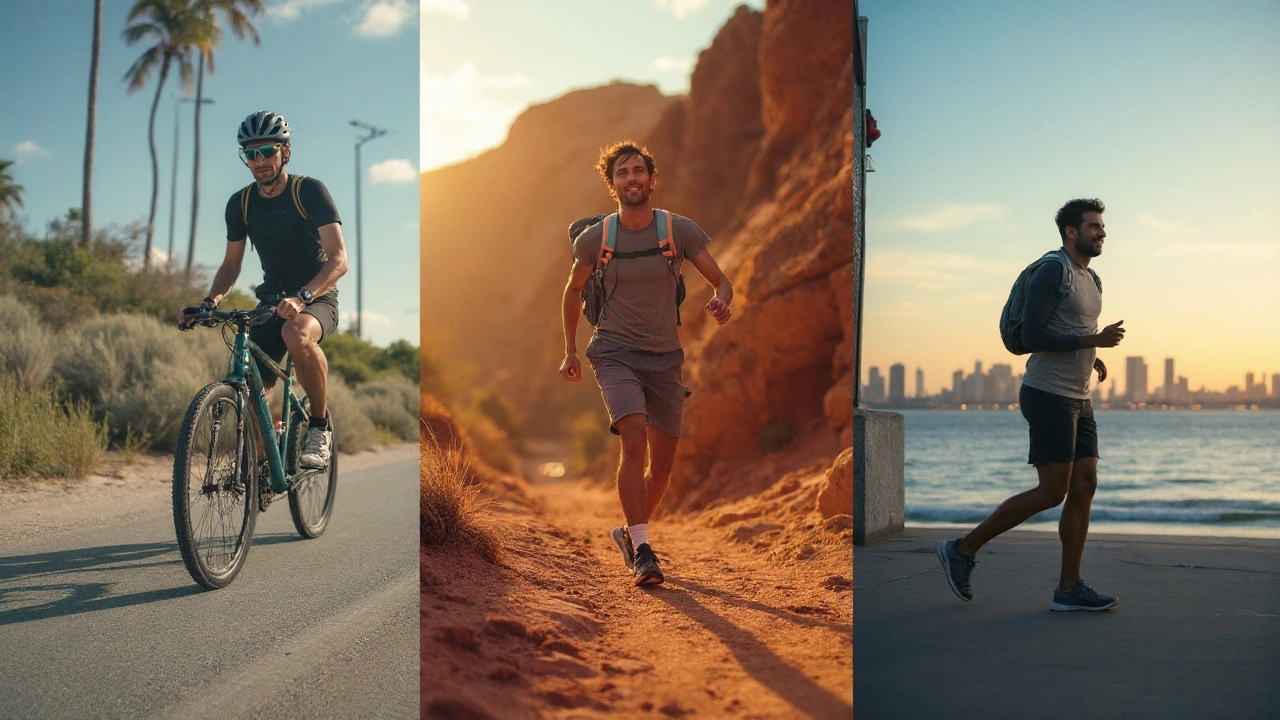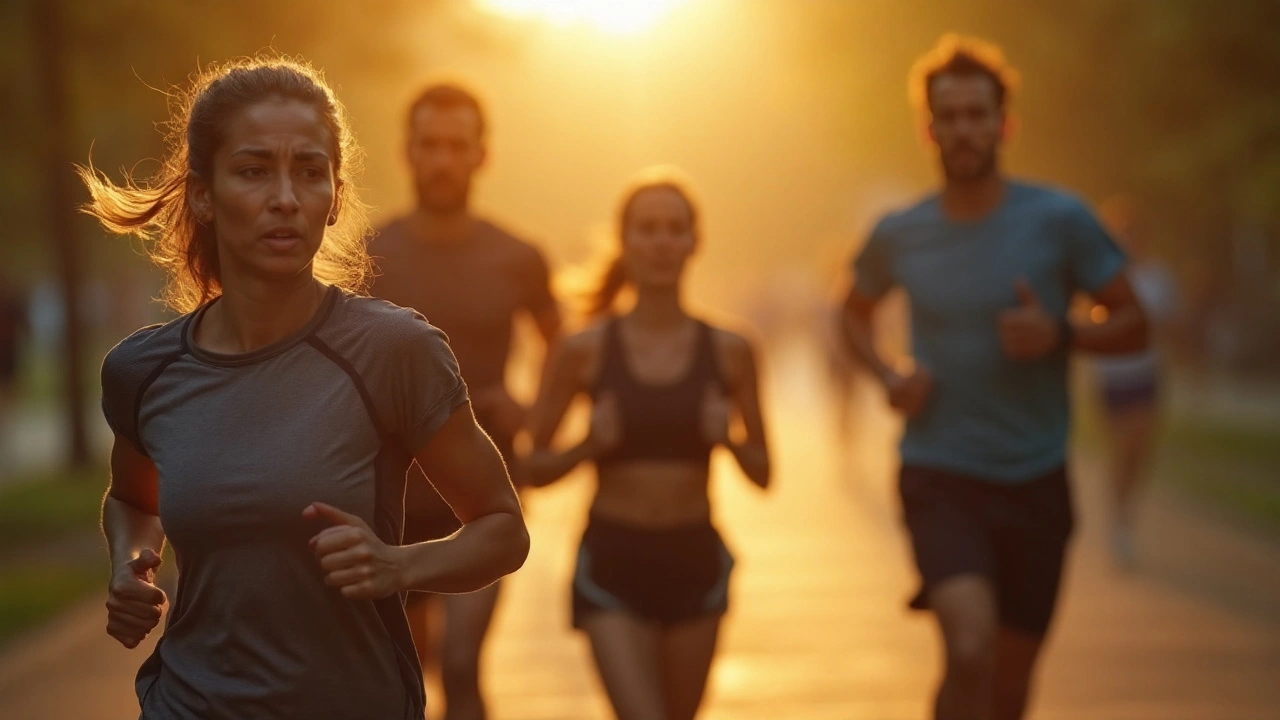If your thighs light up like sandpaper on a humid day, you’re not imagining it. Chafing is friction plus moisture plus heat. The right fabric breaks that chain-by moving sweat off your skin, drying fast, and gliding instead of grabbing. I live in Darwin, where the air can feel like soup, and the wrong tee can ruin a run by kilometer three. This guide lays out the best fabrics that actually cut chafe, what to wear when, and how to dodge expensive mistakes.
Quick heads-up: fabric helps a ton, but it can’t fix poor fit, rough seams, or a pack rubbing the same spot. I’ll call those out too, with easy fixes you can use today.
- TL;DR: Pick light, smooth synthetics (polyester or nylon blends) for hot, humid days and long effort. Choose fine merino blends for cooler temps or if odor matters most.
- Hard no: cotton next to skin during sweat. It holds water, swells, and grabs your skin.
- Key rule: smooth face + quick dry + right fit beats any label. Look for microfibers, flat seams, and gentle compression where skin rubs.
- Best all-rounders: polyester microfibre tees and nylon/elastane compression shorts or liners; merino-nylon socks and base layers in cool weather.
- Have a backup: a glide balm or powder for hot spots on long days. Fabric does 80%; lube or powder covers the rest.
How to choose fabrics that stop chafing
Before we rank fabrics, lock down the criteria that matter. Chafing is mostly about surface friction and how wet the fabric stays against your skin. Dermatology guidance (American Academy of Dermatology, 2024) puts sweat and repetitive rubbing at the center; sports textile studies back that hydrophobic, quick-dry fibers reduce skin friction over time compared with wet cotton.
- Moisture handling: You want hydrophobic fibers (polyester, polypropylene) that pull sweat from skin and dry fast. Nylon absorbs a bit more than polyester but often feels smoother and tougher.
- Dry time: The faster a fabric dries, the less time your skin swells and softens. Swollen skin is easier to irritate and break.
- Surface smoothness (glide): Microfiber yarns and tight, smooth knits reduce grab. Look for a silky face with minimal texture.
- Weight and airflow: Lighter knits (120-160 gsm tops; 140-200 gsm shorts liners) drop cling in heat. Mesh panels under arms and between thighs help.
- Stretch and recovery: A touch of elastane (5-12% in shorts/liners, 5-8% in tops) keeps fabric in place so it doesn’t bunch and rub.
- Odor and feel: For multi-day wear, merino’s natural odor control can trump a tiny drying penalty, especially in mild or cool weather.
- Seams and construction: Flat or bonded seams, gussets where thighs meet, and wide waist/leg bands reduce local hot spots.
Rules of thumb I use in tropical heat:
- “Sweat > 30 minutes” rule: If I’ll sweat longer than half an hour, I wear synthetics next to skin-never cotton.
- “Two-finger fit” for liners: Compression shorts should feel supportive but not bite. If you can slide two fingers under the leg band, you’re good.
- “Quick pinch” test: Pinch the fabric and twist. If it rasps like a kitchen sponge, it’ll rub when wet.
Best fabrics for preventing chafe (ranked and why)
Here’s how common clothing fibers stack up when the goal is less friction and less wet cling.
- Polyester microfibre: The workhorse for hot conditions. It’s hydrophobic, wicks well when knitted right, and dries quickly. Microdenier yarns create a smooth face that glides. Great for tees, shorts, bras, and underwear. Modern cationic polyester blends can also feel softer and take dye better.
- Nylon (with elastane): Slightly more absorbent than polyester but very tough and often smoother. In compression liners and tights, nylon/elastane blends hug gently and stop skin-on-skin contact-huge for inner thighs. Ideal for underwear, bike liners, and form-fit layers.
- Polypropylene: The driest fiber on paper, with near-zero moisture regain. It’s super quick to dry and light. Downsides: can feel plasticky, pills, and gets smelly fast. Best as an inner layer in extreme sweat situations or under shorts where airflow is decent.
- Merino wool (17.5-19.5 micron), often blended with nylon: Excels in odor control and comfort when temps are mild to cool. Fine merino handles moisture in the fiber but still feels dry-ish next to skin. It’s slower to dry than synthetics, and heavy sweat in humid heat can make it feel clingy. Blends with nylon boost durability.
- Tencel/Modal (lyocell-based blends): Very smooth and cool to the touch. Manages moisture better than cotton but still absorbs more than polyester, so it can stay damp in heavy sweat. Works well for casual wear, travel tees, and sleepwear that’s gentle on skin.
- Bamboo viscose: Soft and drapey, but don’t be fooled by the marketing-this is viscose (regenerated cellulose). It absorbs a lot, stays wetter longer than synthetics, and can drag under load. Fine for pajamas or light daily wear; not ideal for long runs or hikes.
- Silk: Slippery and gentle, but loses strength when wet and dries slowly compared with synthetics. Great for sleepwear or under a dress shirt; risky for endurance sport.
- Cotton: Comfortable when dry, but it soaks, swells, and chafes in motion. Save it for low-sweat days or outer layers only.
Evidence snapshot: A 2015 Journal of Sports Sciences paper comparing base layers in endurance exercise found lower skin wettedness and faster drying with polyester vs cotton, correlating with fewer reports of irritation. Textile Research Journal studies show friction coefficients jump as cotton saturates, while hydrophobic knits maintain lower surface friction across time. That lines up with real-world experience in wet heat.

Side-by-side comparison: performance, feel, and cost
Use this to match fabric to your situation. Ratings are relative within apparel context.
| Fabric | Wicking/Spread | Dry Time | Glide (Smoothness) | Odor Control | Durability | Typical Price | Best For | Not For |
|---|---|---|---|---|---|---|---|---|
| Polyester microfibre | Excellent | Very fast | High (with tight knit) | Fair (needs treatment) | Good | $ | Hot/humid runs, gym, daily tees | Multi-day wear without washing |
| Nylon + elastane | Very good | Fast | Very high | Fair | Very good | $$ | Compression liners, tights, underwear | Ultra-hot sun if fabric is heavy |
| Polypropylene | Excellent | Very fast | Medium | Poor | Fair | $ | Base layer for heavy sweat in heat | Multiple wears; odor-sensitive use |
| Merino (17.5-19.5µ) blends | Good | Moderate | Medium-High | Excellent | Fair-Good | $$$ | Cool/mild weather, travel, socks | Tropical downpours, max sweat |
| Tencel/Modal blends | Good | Moderate | High | Good | Fair | $$ | Casual wear, sleep, sensitive skin | Marathons, steep hikes in heat |
| Bamboo viscose | Good | Slow-Moderate | High | Fair | Fair | $$ | Lounging, office, low-sweat days | Endurance sport, humid long runs |
| Silk | Medium | Slow | Very high | Fair | Poor when wet | $$$ | Sleepwear, gentle layers | Sweaty activity, backpacks |
| Cotton | Poor | Slow | Low when wet | Fair | Good (heavy knits) | $ | Dry casual, outer shirts | Anything sweaty next to skin |
Quick pick guide:
- Hot and humid (think Darwin wet season): Polyester tee + nylon/elastane thigh-length liner shorts under any shorts/dress/skirt.
- Cool mornings, mild afternoons: Merino-nylon base (150-200 gsm) top + nylon liner short.
- Long travel days: Tencel/Modal or merino tee for comfort and odor; nylon underwear to prevent thigh rub.
- Salt, sand, and sweat: Nylon shorts with a smooth liner are less abrasive than rough recycled poly weaves. Rinse salt out after.
What to wear for different activities and climates
Here’s how I outfit for common scenarios. This blends lab wisdom with the reality of sweat, straps, and miles.
- Running (30-120 minutes): Lightweight polyester microfibre tee (100-140 gsm), thigh-length nylon/elastane liner (6-9” inseam) or split shorts with built-in liner, and synthetic socks. If you chafe under arms, go sleeveless with deep armholes or a singlet with bonded edges.
- Running (trail, long): Same as above but add merino-nylon socks for blister/odor control. Use a smoother, tighter-knit tee to prevent pack strap rub. If it’s drizzly, a thin nylon wind shell over the tee reduces wet cling without trapping heat.
- Cycling/Spin: Proper chamois shorts (nylon/elastane) with a smooth, compressive leg and flat grippers. Polyester or nylon jersey. Cotton anything near the saddle will punish you.
- Hiking/Backpacking: For warm weather, polyester or nylon tee plus liner shorts. In mild or high-altitude conditions, a 150-200 gsm merino-nylon tee works well under a nylon overshirt to buffer shoulder straps. Pack a spare tee to swap when soaked.
- Gym/HIIT: Polyester or nylon tops; nylon/elastane leggings or liners. Look for gussets in tights so the seam isn’t dead center. Bonded or flat seams only.
- Daily wear in heat: Smooth polyester polo or Tencel tee for the office; nylon underwear that reaches mid-thigh to stop skin-on-skin friction under chinos or a dress.
Fit and build details that matter more than you think:
- Length of liners: If your thighs touch, go longer. 6-9” inseam usually beats 3”. A longer hem means the band sits where it won’t roll.
- Seam placement: Inside thigh seams are the enemy. Look for wrapped panels or gussets that move seams away from high-friction zones.
- Waist and grippers: Wide waistbands and soft silicone leg grippers hold fabric flat without cutting in.
- Fabric face: Shiny outside is often smoother. If the inside has mini loops or high texture, you may feel it when soaked.
When odor and skin sensitivity drive the choice:
- Merino blends shine for multi-day, cool-to-mild conditions. Go for 17.5-19.5 micron fibers for softness. A 50-70% merino with nylon core yarn balances durability.
- Tencel/Modal blends feel cool and calm on sensitive skin. Great for sleep and casual days, but switch to synthetics for long, sweaty sessions.
If you’re between sizes, size up for tops (to promote airflow) and go true-to-size for liners (to avoid fabric drift). Too tight causes pressure hot spots; too loose bunches and rubs.

FAQs, next steps, and troubleshooting
Best for / Not for cheat sheet:
- Polyester microfibre: Best for hot runs and gym. Not for multi-day backpacking without wash access.
- Nylon/elastane liners: Best for thigh rub and under skirts/shorts. Not for extreme heat if fabric weight is heavy.
- Merino blends: Best for cool weather and odor control. Not for tropical downpours or sprint sessions.
- Polypropylene: Best as a base in heavy sweat with immediate dry time. Not if odor runs your life.
- Tencel/Modal: Best for sensitive-skin daily wear. Not for endurance workouts.
- Bamboo viscose: Best for lounge. Not for long, sweaty activity.
- Cotton: Best for dry, low-intensity days as outerwear. Not next to skin when you’ll sweat.
Decision checklist before you buy:
- Touch test: Inside surface smooth as a slip? Good. Rough terry-like loops? Skip.
- Compression check: Two-finger rule at the hem and waist. No digging, no rolling.
- Seam audit: Flat or bonded seams only in high-friction zones. Look for a diamond or gusseted crotch.
- Fabric spec: Hydrophobic base (poly/nylon) with 5-12% elastane for stretch in liners; lighter knit for tops in heat.
- Dry test: Spritz water on a spot. If it spreads and dries fast, you’re on the right track.
Care and lifespan tips to keep glide high:
- Skip fabric softeners. They coat fibers and crush wicking. Use a sports detergent.
- Cold wash, gentle spin. Hot water can wreck elastane and speed up pilling.
- Air dry when you can. High heat weakens stretch and invites snags.
- Retire gear when the face pills or the liner gets shiny-thin-both raise friction.
Simple decision tree:
- Hot + humid + >45 min sweat: Polyester tee + nylon/elastane liner shorts.
- Mild/cool + long day + limited washing: Merino-nylon top + nylon/elastane liner.
- Max odor concern: Merino blend top; synthetic liner for thighs.
- Salt/sand exposure: Nylon outer short with soft lining; rinse after.
Troubleshooting common problems:
- Inner thigh burn by 5 km: Add thigh-length nylon/elastane compression liners under your shorts. If you already do, size up the outer short to reduce squeeze.
- Underarm rub: Switch to a sleeveless or a tee with wider armholes and bonded seams. Consider a smoother knit (tighter, silkier polyester).
- Sports bra chafe: Look for brushed, bonded channels, wide straps, and a slick lining fabric. Any rough edge or exposed stitch is a risk when soaked.
- Sock hotspots: Synthetic or merino-nylon socks with a smooth toe seam. Avoid cotton. If your feet drench, carry a second pair and switch mid-session.
- Pack strap rub: A nylon or tightly knit poly tee under the straps reduces grab. Avoid textured pique knits with a pack.
FAQs
- Can I wear cotton if I treat my skin? You can, but you’ll be managing symptoms, not causes. Cotton stays wet and increases friction. If you must, keep cotton as an outer layer with a synthetic or merino base beneath.
- Are bamboo fabrics good for chafe? Bamboo viscose is soft, but it holds more moisture than synthetics. Fine for low-sweat days. For runs or hikes, pick polyester or nylon next to skin.
- Is merino too warm for summer? In dry heat or short sessions, fine merino can work. In humid heat, it can feel clingy when drenched. I reach for polyester in Darwin’s wet season.
- Nylon or polyester for liners? Nylon/elastane usually feels smoother and tougher, which I prefer for thigh liners. Polyester can work too if the knit is tight and slick.
- Do powders or balms replace fabric choice? No, they complement it. Use a silicone-based balm or petroleum jelly on known hot spots for long efforts, but still wear smooth, quick-dry fabrics.
Next steps: try this simple kit
- For hot, sweaty runs: Polyester microfibre tee + nylon/elastane 6-9” liners + synthetic or merino-nylon socks. Keep a mini glide stick in your pocket.
- For mild mornings or travel: Merino-nylon tee + nylon underwear; pack a light poly tee to swap if you soak through.
- For gym/HIIT: Nylon/elastane shorts or tights with gusset + slick polyester top, bonded seams if you can find them.
One last personal note: on the stickiest Darwin days, even the best fabric needs help. I’ll dust a little non-talc powder on inner thighs before a long run, wear a silky nylon liner, and choose a tight-knit polyester singlet. That combo lets me focus on the run, not the rub. If you nail the fabric and the fit, you’ll forget about chafing-exactly how it should be.
Oh, and if you share laundry duty like I do with Patrice Lavelle, put a note on the machine: no softener. Your gear-and your skin-will thank you.
Keyword focus: anti-chafe fabrics deliver best results when paired with the right fit, smooth seams, and fast-drying construction. Use the charts and checklists above, and you’ll feel the difference on your very next sweaty session.



Peter Rupar
1 September / 2025Listen up, folks, if you think cotton is a miracle fabric you’re living in a fantasy. The wet sandpaper feeling you get on a humid run is proof that only synthetics can break that cycle. Stop buying cheap tees that swell like a sponge; invest in polyester micro‑fibre and you’ll thank me later. Your skin will thank you more than any hype‑filled ad.